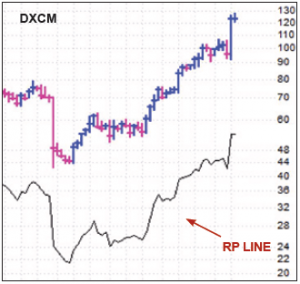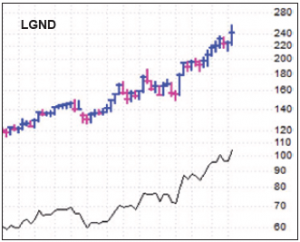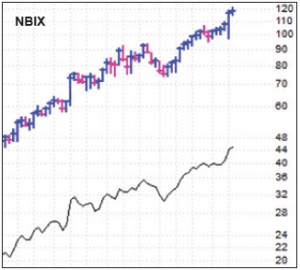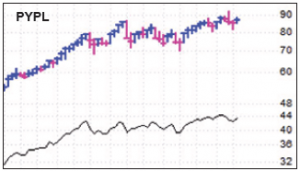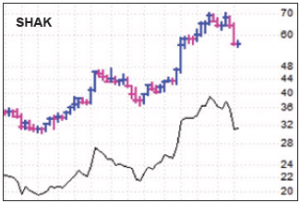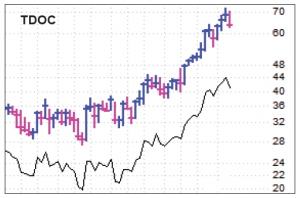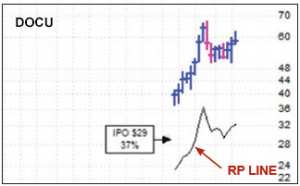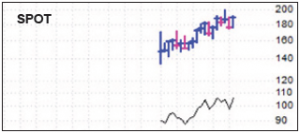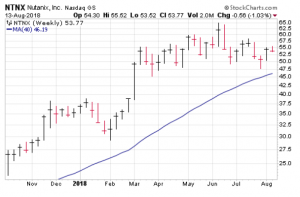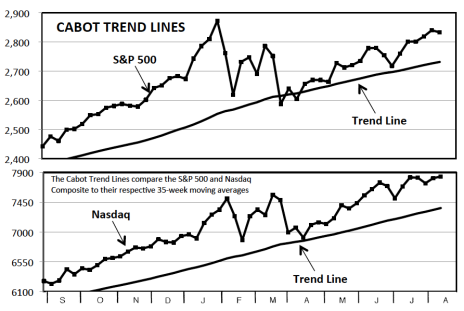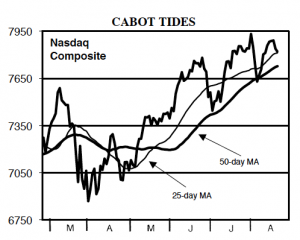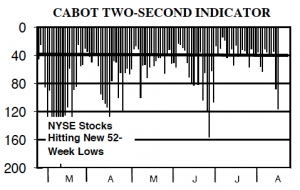The market is positive, but it’s not powerful, with a generally choppy, narrow and rotational environment in recent weeks. Even so, we’re encouraged by the action in some growth stocks, so after getting knocked out of a few names during earnings season, we’ve begun to put some money back to work.
Cabot Growth Investor 1400
[premium_html_toc post_id="156111"]
Positive, not Powerful
When it comes to investing we’re big on rules. That’s because, if you invest solely by emotions and gut instinct, you’re bound to lose your way. That’s why we write about our key market timing indicators in every issue, and why we have a bunch of rules and tools for controlling losses, raising stops, taking partial profits and the like.
That said, there’s frequently room for intelligent thinking that looks at more elements of the picture. For example, most major indexes are perched near all-time highs today, our Cabot Trend Lines and Cabot Tides are both positive, and while our Two-Second Indicator has flared up thanks to the plunge in Turkey’s currency, most growth stocks are still acting well enough.
So the situation is positive—but it isn’t powerful. In fact, during the past two days—even as the major indexes are near their highs—we saw more stocks hitting new 52-week lows than hitting new highs! Taking a step back, we see that growth-oriented indexes like the Nasdaq and S&P 600 SmallCap haven’t made much progress during the past two months (lots of choppiness), and we continue to see rotation among groups on a day-to-day basis.
Nevertheless, we’re encouraged by what growth stocks have done over the past two weeks. After two sharp dips (late June and late July), many have held key support, with some new leadership emerging with the help of earnings. And we’re uncovering a decent number of stocks that have built reasonable two-month bases while the aforementioned growth-heavy indexes chop around.
So what does it mean? As I’ll be talking about at this week’s Cabot Wealth Summit, my biggest conviction is in the longer-term outlook—the odds strongly favor stocks being in the third to fourth inning of the secular (10 to 15 year) uptrend, and as for the current bull market, 2018 looks like a normal rest year after the huge run in 2017. Thus, the next major move is likely up.
The shorter-term, though, is more of an open question. Is the market ready to get going here? Do we chop around for another few weeks? Will September/October bring a correction to put in the year’s final low? There’s still more positive evidence than negative evidence, so you should be leaning bullish. But given the narrowness of the rally and choppy action, it’s best to pick your spots.
[highlight_box]WHAT TO DO NOW: After getting knocked out of a few stocks on weakness, we added Neurocrine Biosciences (NBIX) and averaged up in GrubHub (GRUB) last week. Tonight, we’re buying a stake in DexCom (DXCM), which will leave us with around 27% in cash, which we’re content to hold onto and see how the market acts from here.[/highlight_box]
Model Portfolio Update
We’ve remained flexible with the Model Portfolio in recent weeks, throwing out a few names because of individual weakness (earnings drops, tripping stops, etc.), and then putting some money back to work recently as the tone of growth stocks improved and as some more new leadership emerged.
Our cash position briefly got up north of 50% last week but we put some back to work last week (adding NBIX and buying more shares of GRUB), and tonight we’re adding DexCom (DXCM), bringing our cash down to 27%.
Going forward, we’re not opposed to moving in either direction, but as long as the environment remains choppy, narrow, rotational and news driven, we’ll be stepping carefully, focusing on lower-risk entry points and ideas that appear early in their overall runs.
Current Recommendations
BUY—DexCom (DXCM 127)—We’ve been following DexCom from a distance for a couple of years, as the company has been one of the leaders in the development of continuous glucose monitors (CGMs). And DexCom’s latest iteration (dubbed the G6), which just hit the U.S. market in early June (European launch later this year), is by far tops in the sector—it allows diabetics to see their blood sugar level throughout the day via a sensor implanted under the skin (no blood necessary) with alerts, alarms and analytics (which can be sent to a smartphone) when levels get outside the normal range. The product is very easy to use, its sensors last 10 days instead of seven, the product and transmitter are smaller than prior versions and it has the most accurate readings in the industry and eliminates the need for finger sticks. There is some competition in the industry (from Medtronic and Abbott), but (a) this is a big growth market, with CGM use across both Type 1 and Type 2 diabetics expected to increase sharply during the next couple of years due to technological advancements, and (b) the G6’s combination of accuracy, ease of use and range of features makes it the clear technological leader in the space. (The G6 is also approved for patients as young as two years old, vs. 14 to 18 years old for competing products.) Since the launch, demand has been so strong (from both new users and people switching over from either prior DexCom versions or other CGMs) that the company has had trouble keeping up with demand. But that didn’t stop it from blowing away Q2 estimates (revenues up 42%, accelerating from 30%, 29% and 24% the prior three quarters), which caused the stock to gap up in a big way, lifting out of a three-year base and holding firm since. Admittedly, it’s not a perfect entry point, and we’ll be using a loose stop down in the mid 100s. But the powerful fundamental story, the strong gap on earnings and the tight action since are enough for us to buy.
HOLD—Five Below (FIVE 106)—FIVE remains in its consolidation phase, but has perked up nicely in recent days, partly due to some soothing words from an analyst last week, whose channel checks indicated that the company’s sales momentum accelerated throughout its fiscal Q2 (ending July 31), prompting him to bump up his same-store sales estimates for the quarter. He also gave a more optimistic view on the long-term picture, thinking there’s room for greater brand awareness and higher margins as the firm scales over time. Bigger picture, we continue to think FIVE has higher prices ahead of it after this rest period ends, though shorter-term, we’re not seeing any great upside power, with the recent bump coming on very light volume. If you don’t own any and really want in, we’re fine with taking a nibble here or on dips. But officially we’ll just stick with our Hold rating until we see some clear signs the buyers are more active.
BUY—GrubHub (GRUB 129)—We added a few more shares to our position of GRUB last week after the stock settled down a bit following a hectic (mostly positive) post-earnings reaction. Obviously, the market will have a near-term impact on the stock, so we can’t rule out another dip. But from today’s perspective, the push to new highs looks like a resumption of GRUB’s longer-term uptrend, especially considering the tameness of the prior consolidation (just 20% from high to low after shares doubled over the prior five months) and the huge fundamental story. If you don’t own any, you can start with a smaller-than-normal position; if you own some with a big profit, you can add a small amount to your holdings.
BUY—Ligand Pharmaceuticals (LGND 249)—Ligand announced its intention to buy a British-based drug discovery outfit for $43 million; if approved by shareholders, Ligand would gain eight fully funded partner programs and plenty of early-stage, unpartnered programs in a variety of areas. (The deal shouldn’t affect earnings much for the foreseeable future.) That’s a small piece of good news, but LGND itself is still basking in the glow of its quarterly report, where management bumped up its royalty outlook for 2018 and basically reiterated that it has a ton of irons in the fire (or, as the company likes to say, shots on goal). The stock has stretched to new highs, though it’s extended to the upside from its 25-day (now around 229) and 50-day (215 or so) moving averages. We think LGND just kicked off a sustained advance in May, so longer term, we have high hopes. Near term, we’ll stay on Buy, though we advise aiming for dips of a few points given the choppy market environment.
BUY—Neurocrine Biosciences (NBIX 116)—NBIX was added to the Model Portfolio last Thursday, and we think it remains a solid Buy around here. The company is one of many biotechs that have recently transitioned from development stage to commercial stage, and while the valuation is high, so is the potential. The company’s Ingrezza is the only treatment for Tardive Dyskinesia (uncontrolled movements in the face, tongue or other body parts), which is a side effect of certain antipsychotic medications; growth since its launch a year ago has been fantastic and currently accounts for all of the firm’s revenue. But not for long! Neurocrine’s partner AbbVie just got approval for Orillissa (for a uterus growth abnormality)—after including some expected label expansions in the next year or two, many analysts think that can be a $1 billion drug, and Neurocrine is in line for big royalties from the product. We have a mental stop in the 100 area in case things don’t go as planned, but analysts see the bottom line reaching into the black this year and surging to $1.74 per share in 2019—both of which could prove conservative. If you don’t own any, you can grab some shares here.
HOLD—Okta (OKTA 56)—OKTA remains a wild child on a day-to-day basis, but overall, we’re intrigued—two weeks ago the stock looked ready to crack, but shares snapped right back toward their highs until the Turkey-inspired pullback hit the market late last week. On the weekly chart, the stock’s past two months look like a relatively normal consolidation after a big run from February (when it initially got going from a post-IPO base) through early June. As we usually do, we’re aiming to be patient with OKTA as long as it holds above our mental stop (in the 48 area). Yes, the stock could always fall apart, but should the uptrend resume, the potential upside is far larger than the downside risk from here. (On the upside, a decisive move above 60 would be highly encouraging.) Bottom line, if you own some, grit your teeth and hang on. Earnings are due out September 6.
HOLD—PayPal (PYPL 88)—After falling about 11 points from high to low, PYPL has recouped as many as seven of those points, a fair showing after the late July dip. That said, the near-term action (big-volume selloff, light volume rally) isn’t a low-risk setup, so we’ll stay on Hold. The company has been quiet on the news front since its earnings release, but it’s a plus that analysts have basically maintained their earnings estimates (up 23% this year, up 21% next, with similar growth in the years beyond) following the Q2 report. If, you own some, we advise patience.
SOLD—Shake Shack (SHAK 59)—Shake Shack got whacked on earnings on Friday, August 3, which prompted us to sell the following Monday. Actually, it wasn’t just the earnings drop that did it—given that we had a decent profit in SHAK a few weeks ago, the fact that the stock fell back below our buy point triggered a sell signal. Fundamentally, the expansion plan is still generally on track, but it looks like the top brass are having trouble opening enough locations fast enough to meet their aggressive targets. We still think Shake Shack could eventually morph into a leading stock, but it’s probably going to have to prove that the expansion plan is on track in the months ahead. And the stock, which hasn’t been able to bounce since its gap lower, will likely need time to build a new launching pad, and that’s assuming all goes well. We sold last Monday, took a tiny loss and are looking for stronger situations.
BUY—Teladoc (TDOC 72)—Teladoc looks great, having snapped back from its 50-day line to new highs late last week. The quarterly report was very solid, with organic (i.e., not including acquisitions) revenue growth of 39%, including a big bump up in its visit revenue, which is still small (about 16% of revenue) but growing quickly (thanks to a 41% leap in paid visits and a 23% organic bump in paid membership). But possibly more encouraging was the announcement we wrote about in last week’s update—CVS’s medical clinic operation (MinuteClinic) will be leveraging Teladoc’s technology to launch its own virtual care operation, which backs the view that (a) Teladoc is the hands-down leader in the sector and (b) there’s potential for more partnerships with other big care providers. Back to the stock, it remains very volatile, so expect some wiggles, but the main trend is up and we think plenty more big investors will be looking to get in if the market behaves itself (420 mutual funds now own shares, up from 318 a year ago). We’ll stay on Buy.
Watch List
Carvana (CVNA 55): CVNA leapt to new highs on earnings, a move that in a stronger market environment, could be buyable. With shares 28% above their 50-day line (!), we’ll be looking for a lower-risk entry point.
DocuSign (DOCU 58): DOCU is recently public and still pretty choppy, but is setting up a decent base and has a sturdy story. See more below.
Spotify (SPOT 194): SPOT has snapped back nicely from its post-earnings dip in late July. We think this well-traded stock ($350 million of volume per day!) is under accumulation and could be a new leader. See more on page 5.
Stitch Fix (SFIX 34): SFIX has a great story and solid revenue growth, and while its uneven earnings projections aren’t ideal, we’re putting more weight on its leadership position in an entirely new industry.
Other Stocks of Interest
The stocks below may not be followed in Cabot Growth Investor on a regular basis. They’re intended to present you with ideas for additional investment beyond the Model Portfolio. For our current ratings on these stocks, see Updates on Other Stocks of Interest on the subscriber website or email mike@cabotwealth.com.
DocuSign (DOCU 58) — Preparing, exchanging and signing documents is a cumbersome and expensive business, and one that DocuSign wants to help with. DocuSign’s System of Agreement platform allows for autofilling information, uploading and sending documents and electronic signatures (plus reminders and status checks) to speed up the process and get contracts and other agreements done in minutes rather than days. DocuSign’s products are offered via subscription, and the company boasts over 400,000 paying customers (including 18 of the top 20 global pharmaceutical companies and 10 of the top 15 financial services companies) and just turned profitable, with next year’s earnings forecast to pop by 260%. The young (came public in April) stock is setting up well after an IPO rally and a reasonable base-building effort.
Roku (ROKU 56) — As customers are switching away from big cable companies in droves, entertainment choices like Roku’s streaming devices (players, smart TVs and wireless speakers) are gaining in popularity. Content providers can offer shows to Roku owners, building huge audiences and cutting their own deals with advertisers. Revenue growth has been strong—25% in 2016, 29% in 2017 and 36% and 57% in the two latest quarters. And analysts are looking for profitability in 2019. Roku has only been public since September 2017, and it’s been a wild ride. But from a correction low of 29 in April (down from 59 in December 2017), the stock staged a picture-perfect rally to 49 last Wednesday, before an earnings-inspired gap up to 58 on massive volume (four times its average). ROKU may need some time to set up, but it’s a big story with accelerating growth.
Spotify (SPOT 194) — Luxembourg-based Spotify offers online music services to about 180 million monthly active users (MAU) who can get access to its 35 million music tracks by either paying for ad-free access or via free accounts that include ads. The company isn’t profitable, yet, but losses are moderating, and any company with 180 million MAU is bristling with potential. The company just signed a deal with Samsung, making Spotify the official music provider for all Samsung products (smartphones, TVs, tablets, etc.), meaning it will be integrated into the set-up process on all new devices and merged into Samsung’s voice assistant program on smart-home apps. It’s a big plus in the firm’s competition with Apple Music. SPOT has been all over the place, but got a nice boost to near 200 after its July 26 quarterly report and—after a post-earnings dip to 175—back into the 190s after the Samsung news. We like it.
Investors Aren’t Buying the Latest Rally
We continue to keep track of total money flows into equity funds, thinking it has a chance to be a key contrary market timing indicator for us. Indeed, just since last December, the shorter-term (four-week) moving average of fund flows has done a great job of spotting extremes in sentiment that have led to reverses in the market’s direction.
For instance, the low ebb in December came before the market’s huge run-up in January; the January gush of inflows came before this year’s market peak; and the low ebbs in early April and late June preceded rallies for the S&P 500. It’s never going to be a primary timing measure, but we’re optimistic it can highlight times to lean against the wind, especially given its very broad (all equity funds and ETFs) and direct (real money people are putting in or pulling out) features.
But we’re writing about money flows today because, for the first time this year, investors aren’t buying into a meaningful rally. The top chart shown here is of the S&P 500—while growth stocks have had their downs and ups in recent weeks, the S&P 500 has marched higher since late June, approaching its January peak before the recent Turkey-inspired hesitation.
But now compare the index to the cumulative equity fund flows so far this year. For the most part, money flows have chopped up and down with the S&P 500 this year, but take a look at the last few weeks—basically no money has come into the market despite the rally, and this comes after a ton of money was yanked out in the second half of June.
Of course, there are a couple of secondary indicators right now that are telling a cautionary tale, such as the low number of stocks hitting new highs even as the indexes stand near all-time highs. But we consider money flows to be a feather in the bulls’ cap—after months of choppy action and worrisome news, investors are skeptical this rally is for real, which usually bodes well for higher prices in the weeks ahead.
Is It Prudent to Buy a Stock Back After You Sold?
Yes! Just because you get knocked out of a stock on weakness (whether from the stock itself or the market as a whole) is no reason to ignore that name forever forward. But, like most things in the market, it’s best to have some guidelines when thinking about jumping back into something you recently sold.
First, if you get knocked out of a stock, it’s usually best to let it sit for a few days. We regularly get calls from people who were stopped out of XYZ in the morning and now wonder whether to buy it back that afternoon. That’s too soon, and most likely, emotion is playing a role in that desire to get back in. In almost all cases, it’s better to simply put it back on your watch list and look at it the following weekend to see where it’s at.
Second, once you sell, you shouldn’t be biased for (or against) the stock. In other words, you should compare it to all other names on your watch list—if it has the best combination of story, numbers and chart, then you can consider getting back in. But it should be the best of the best you can find, not just a name you want to own again because you owned it before.
Third, when you do get back in, make sure you have an exit plan. That goes for every stock, of course, but if you buy back a stock you recently sold out of, be honest—there’s probably some emotion involved, which may make cutting it loose that much harder if things go awry. So have a plan.
And fourth, it’s a good idea to have a maximum number of times you’ll own a stock within a given period of time. If you’re in and out three or four times within three months, it probably means the stock isn’t for you—its action doesn’t fit the way you trade. Best to leave it be.
Believe it or not, some of our best trades have come on a second attempt on a stock. Five Below (FIVE) was initially bought back in the spring of 2016, for exmple, but after a nice initial run, we sold that summer for a modest gain. While the stock showed some positive signs after that sale (including a nice run in early 2017), we didn’t get back on board until later that year—and, of course, it’s done very well since.
Right now, we’re keeping a close eye on Nutanix (NTNX), which we still feel is early stage and has a fundamental story that will keep big investors interested. We got knocked out last month, and the stock still isn’t as strong as other names we’re watching—but these past few months could still prove to be a normal pause after its huge run-up this March. If it pushes back toward its highs and growth remains rapid, we could revisit it—but if it doesn’t, we’ll look elsewhere!
The bottom line is, yes, buying something back after you sell is OK, but as always, make sure you’re buying for good reasons: the stock is strong, growth is excellent, and it’s one of the top few pieces of merchandise you can find in the entire market. Leave emotions out of it.
Cabot Market Timing Indicators
When looking at the market’s trends and the action of most growth stocks, there’s no question the majority of evidence is bullish. That said, it’s also a news-driven and rotational environment, so picking your spots and following your plan remains essential.
Cabot Trend Lines: Bullish
Our Cabot Trend Lines haven’t given us any hesitation in thinking the overall bull market remains intact throughout this year, and that remains the case today. Last week, the S&P 500 (by 3.7%) and Nasdaq (by 6.5%) closed solidly above their respective 35-week moving averages, keeping the longer-term trend pointed firmly up.
Cabot Tides: Positive
Our Cabot Tides are positive, as the major indexes found support two weeks ago and have pushed generally higher since. Of course, it’s still not a powerful situation—the Nasdaq (daily chart shown here) hasn’t made much progress since mid June and isn’t far above its 50-day line. But just going with the evidence, the intermediate- and longer-term trends are pointed up, which is reason enough to at least lean bullish.
Two-Second Indicator: Neutral
The Two-Second Indicator continues with its close-but-no-cigar stance—the number of new lows has generally dried up in recent weeks, but been unable to stay below 40 for any length of time. Thus, the broad market effectively remains neutral, and we’ll be watching for a consistent decline in the new low readings for signs the buyers are taking control.
[premium_html_footer]
Send questions or comments to mike@cabotwealth.com.
Cabot Growth Investor • 176 North Street, Post Office Box 2049, Salem, MA 01970 • www.cabotwealth.com
All Cabot Growth Investor’s buy and sell recommendations are made in issues or updates and posted on the Cabot subscribers’ website. Sell recommendations may also be sent to subscribers as special bulletins via email and the recorded telephone hotline. To calculate the performance of the portfolio, Cabot “buys” and “sells” at the midpoint of the high and low prices of the stock on the day following the recommendation. Cabot’s policy is to sell any stock that shows a loss of 20% in a bull market (15% in a bear market) from our original buy price, calculated using the current closing (not intra-day) price. Subscribers should apply loss limits based on their own personal purchase prices.
Charts show both the stock’s recent trading history and its relative performance (RP) line, which shows you how the stock is performing relative to the S&P 500, a broad-based index. In the ideal case, the stock and its RP line advance in unison. Both tools are key in determining whether to hold or sell.
THE NEXT CABOT GROWTH INVESTOR WILL BE PUBLISHED AUGUST 29, 2018
We appreciate your feedback on this issue. Follow the link below to complete our subscriber satisfaction survey: Go to: www.surveymonkey.com/marketlettersurvey
Neither Cabot Wealth Network nor our employees are compensated by the companies we recommend. Sources of information are believed to be reliable, but are in no way guaranteed to be complete or without error. Recommendations, opinions or suggestions are given with the understanding that subscribers acting on the information assume all risks. © Cabot Wealth Network. Copying and/or electronic transmission of this report is a violation of U.S. copyright law. For the protection of our subscribers, if copyright laws are violated, the subscription will be terminated. To subscribe or for information on our privacy policy, call 978-745-5532, visit www.cabotwealth.com or write to support@cabotwealth.com.
[/premium_html_footer]


